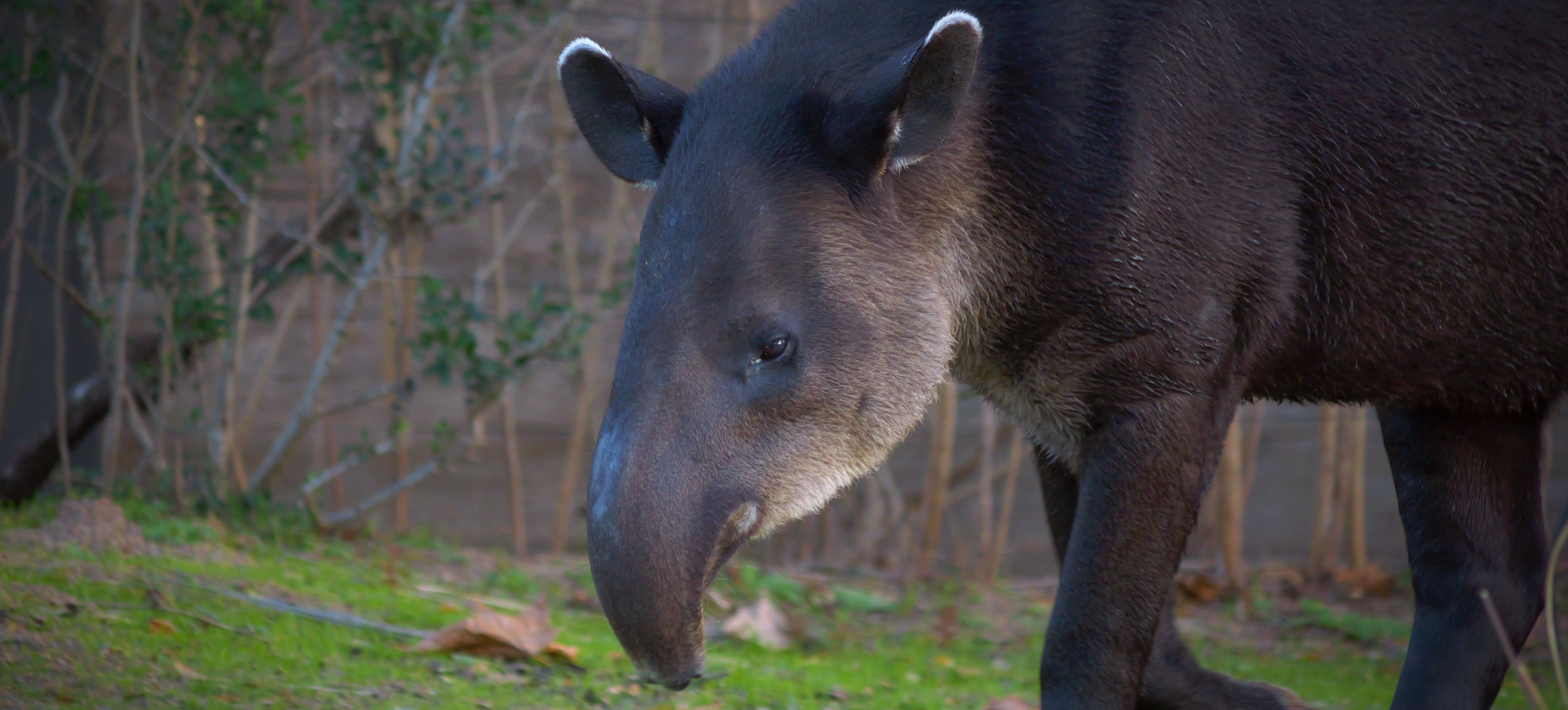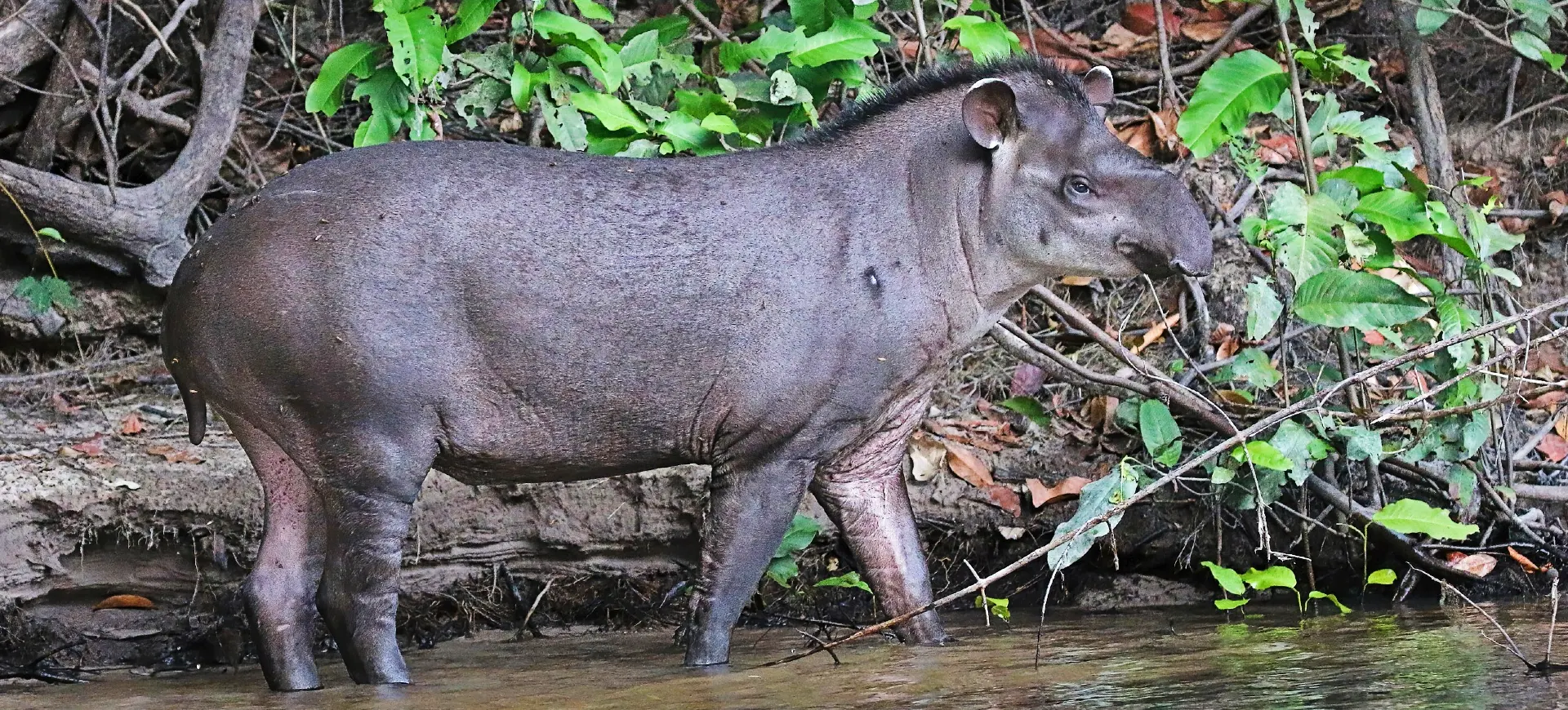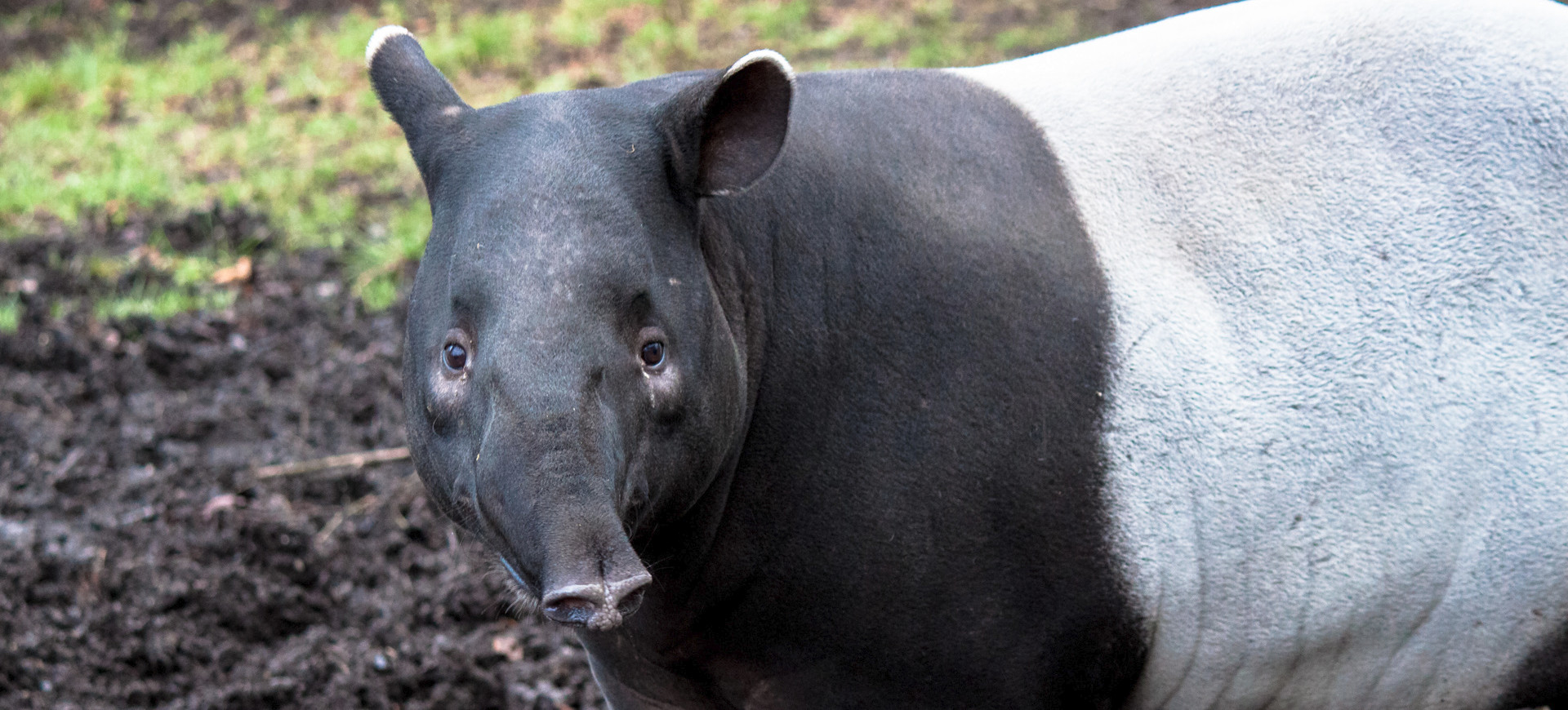Overview
The Mountain Tapir, scientifically known as Tapirus pinchaque, is a unique and lesser-known species among the Tapir family, primarily found in the high-altitude environments of the Andes Mountains. This species is characterized by its woolly coat, which adapts to its cold mountainous habitat, distinguishing it from its lowland relatives. The Mountain Tapir is the smallest tapir species. Yet, it plays a significant ecological role within its ecosystem, facilitating seed dispersal and contributing to the health and diversity of its montane forest and paramo habitats. Its shy nature and nocturnal habits make it a difficult species to study, contributing to its mystique and the limited knowledge about its way of life.
Mountain Tapirs have a robust and stocky body with short legs, and their fur is dense and long compared to other tapir species, providing insulation against the cold. Their distinctive prehensile snout is used effectively to grasp leaves, twigs, and fruit, demonstrating their adaptability in foraging across the varied vegetation of their high-altitude range. These tapirs are solitary animals, with adults only coming together for mating purposes and living a largely hidden existence amidst the dense foliage and rugged terrain of their mountainous homes. Despite their critical ecological role and fascinating adaptations, Mountain Tapirs face numerous threats, including habitat loss, hunting, and the impacts of climate change, making them one of the most endangered tapir species.
The conservation of the Mountain Tapir is a pressing concern, with efforts focused on habitat protection and creating ecological corridors to ensure genetic diversity and population stability. These tapirs are an indicator species for the health of their unique ecosystem, and their decline signals broader environmental issues that need to be addressed. Conservation initiatives also involve local communities, aiming to reduce hunting pressure and promote sustainable land use practices that benefit both the tapirs and the people close to their habitats. As emblematic species of the Andean region, Mountain Tapirs are a priority for conservation, embodying their mountainous realm’s rich biodiversity and ecological complexity.
Taxonomy
Kingdom
Phylum
Class
Order
Family
Genus
Species
Type
Physical Description:
The Mountain Tapir is distinguished by its dense, woolly fur, a unique adaptation among tapirs that helps it survive in the chilly climates of the Andes Mountains. The fur is generally black or dark brown, providing camouflage in the shadowy underbrush of its mountainous habitat. Adults exhibit a relatively compact body size compared to other tapir species, with a pronounced hump above the shoulders, adding to their distinctive silhouette. The facial markings of the Mountain Tapir, including a white rim around the lips and ears, contrast with their darker body fur, giving them a striking appearance.
These tapirs are relatively small, with adults typically measuring about 5.9 to 6.6 feet (180 to 200 cm) in length and standing about 2 to 2.5 feet (60 to 76 cm) tall at the shoulder. Despite their robust build, Mountain Tapirs are agile climbers, capable of navigating their habitat’s steep and rugged terrain. The prehensile snout, a common feature among tapirs, is especially useful in the dense vegetation of high-altitude forests, allowing them to reach and consume a variety of plant materials. The physical characteristics of the Mountain Tapir, including its size, coat, and coloration, are direct adaptations to its environment, illustrating the evolutionary processes at work in isolated ecosystems.

Lifespan: Wild: ~25 years || Captivity: ~30 years

Weight: Male: 220-550 lbs (100-250 kg) || Female: 220-550 lbs (100-250 kg)

Length: Male: 71-79 inches (180-200 cm) || Female: 71-79 inches (180-200 cm)

Height: Male: 24-30 inches (60-76 cm) || Female: 24-30 inches (60-76 cm)

Top Speed: 25 mph (40 km/h)
Characteristic:
Native Habitat:
Mountain Tapirs are native to the cloud forests and paramos of the Andes Mountains, inhabiting elevations from about 6,600 to 13,000 feet (2,000 to 4,000 meters). These environments are characterized by dense vegetation, steep terrain, and a cool, moist climate, providing the tapirs with the conditions they need to thrive. The specific vegetation types and rugged landscape of the Andes offer food and shelter, allowing Mountain Tapirs to effectively hide from predators and humans. Their habitat preference makes them highly specialized but vulnerable to environmental changes, such as deforestation, agricultural expansion, and climate change.
The distribution of the Mountain Tapir spans several countries, including Colombia, Ecuador, Peru, and the northern tip of Argentina, though their populations are fragmented and increasingly isolated. Preserving continuous tracts of suitable habitat is critical for maintaining connectivity between populations, supporting genetic diversity, and ensuring the species’ long-term survival. The challenges of conserving Mountain Tapir habitats are compounded by their mountainous homes’ rugged and often inaccessible nature, requiring targeted conservation strategies that balance ecological needs with local human interests.
Climate Zones:
Biogeographical Realms:
Continents:
Diet:
Diet & Feeding Habits:
Mountain tapirs are herbivores that feed on various plants, including leaves, twigs, fruits, and aquatic vegetation, which they find in their montane forest and paramo habitats. Their diet varies seasonally and is adapted to the availability of different plant species at various altitudes. The ability of Mountain Tapirs to consume and digest a diverse range of plant materials plays a crucial role in their ecosystem, aiding in seed dispersal and contributing to the regeneration and health of their habitat. Their feeding behavior demonstrates the tapir’s adaptability and the importance of their ecological niche within the Andean forests.
In addition to browsing on vegetation, Mountain Tapirs are known to visit natural salt licks, which provide essential minerals not found in their regular diet. These salt licks are also important social hubs where tapirs may indirectly interact with one another, highlighting a complex relationship with their environment. The Mountain Tapir’s nocturnal and crepuscular feeding habits help reduce competition for food with diurnal species and minimize exposure to predators. Conservation efforts to preserve Mountain Tapir habitats must consider the range of plant species these animals depend on for sustenance, ensuring the availability of crucial feeding grounds.
Mating Behavior:
Mating Description:
Mountain Tapirs exhibit a polygynous mating system, where males may mate with multiple females when the opportunity arises. The mating season is not strictly defined, and breeding can occur at various times throughout the year, depending on environmental conditions. Males court females with vocalizations and physical displays; if receptive, the female will allow the male to mate. After mating, there is little to no further association between the male and female, with the female assuming all responsibilities for rearing the offspring.
The gestation period for a Mountain Tapir is approximately 13 months, resulting in the birth of a single calf. The newborn is well camouflaged with a coat of stripes and spots, which it loses as it matures. The mother is highly protective of her calf, hiding it in dense vegetation for the first few weeks of life. The calf depends on its mother for milk but begins to explore solid food within a few weeks, gradually learning to forage independently. The extended care the mother provides helps ensure the calf’s survival during its vulnerable early life stages.
Reproduction Season:
Birth Type:
Pregnancy Duration:
Female Name:
Male Name:
Baby Name:
Social Structure Description:
Mountain Tapirs are solitary animals, with individuals typically occupying large, overlapping home ranges. Social interactions are primarily limited to mating encounters and mother-offspring relationships. Tapirs communicate through vocalizations and scent markings, establishing territory, attracting mates, and expressing distress or aggression. Their solitary nature and the need for large territories underscore the importance of conserving extensive, continuous habitats for their survival.
The social structure of the Mountain Tapir reflects its adaptation to life in rugged, high-altitude environments, where resources may be scattered, and predator pressure varies. Establishing and maintaining pathways through their habitat facilitates movement and access to food and water sources. Preserving these natural behaviors and social structures is essential for the well-being and conservation of the Mountain Tapir population.
Groups:
Conservation Status:
Population Trend:
The global population of the Mountain Tapir is estimated to be less than 2,500 mature individuals, with populations continuing to decline due to habitat loss, hunting, and other human-induced pressures. These tapirs are distributed in increasingly fragmented habitats, making it difficult for isolated groups to interact, which is crucial for maintaining genetic diversity and overall population health. Conservation efforts are urgently needed to halt the decline of this species and ensure its survival in the wild. Monitoring population trends and implementing effective conservation strategies are key to these efforts.
Mountain Tapir populations are primarily threatened by habitat destruction and fragmentation resulting from agricultural expansion, deforestation, and infrastructure development within their mountainous habitats. Conservation initiatives focus on protecting and restoring habitat, creating ecological corridors to connect fragmented populations, and reducing human-tapir conflicts. Efforts to increase awareness of the Mountain Tapir’s plight and its ecological importance are also critical for garnering support for conservation measures among local communities and governments.
Population Threats:
The primary threats to the Mountain Tapir include habitat loss and fragmentation due to agricultural expansion, deforestation, mining, and infrastructure development. These activities reduce the available habitat for tapirs and isolate populations, limiting genetic exchange and increasing vulnerability to extinction. Illegal hunting for meat and traditional medicine continues to pose a significant threat despite legal protections. Additionally, climate change is expected to impact the high-altitude habitats of the Mountain Tapir, altering vegetation patterns and water availability and further challenging the survival of this species.
Conservation efforts must address the complex interplay of these threats to ensure the long-term viability of the Mountain Tapir. Protecting large areas of contiguous habitat, enforcing anti-poaching laws, and engaging local communities in conservation are key strategies. Climate change mitigation efforts are also essential, as they will help preserve the ecological integrity of the Andean regions that the Mountain Tapir depends on.
Conservation Efforts:
Conservation efforts for the Mountain Tapir are multifaceted, focusing on habitat protection, anti-poaching measures, and research to better understand the species’ ecology and requirements. Protected areas and national parks play a crucial role in conserving tapir habitats, but efforts are also needed to connect these areas through ecological corridors. Research into the Mountain Tapir’s distribution, population dynamics, and habitat use is essential for informed conservation planning and action. Community-based conservation initiatives aim to involve local populations in protecting tapirs and their habitat, promoting sustainable land use practices that benefit both people and wildlife.
International cooperation is vital for conserving the Mountain Tapir, as its range spans multiple countries. Collaborative projects and funding mechanisms can support cross-border conservation initiatives, habitat restoration, and anti-poaching efforts. Education and awareness campaigns are also important for raising the profile of the Mountain Tapir and its conservation needs, engaging the public and decision-makers in efforts to secure the future of this unique Andean species.
Additional Resources:
Fun Facts
- The Mountain Tapir is the only tapir species adapted to live in high-altitude environments, showcasing unique adaptations such as its woolly coat.
- They are excellent swimmers and can cross rivers and lakes within their mountainous habitats.
- Mountain Tapirs play a crucial role in their ecosystem as “gardeners of the forest,” dispersing seeds through their feces.
- Their prehensile snout acts like a fifth limb, helping them grasp vegetation in their dense, mountainous environment.
- Mountain Tapirs have been depicted in indigenous art and mythology, symbolizing strength and resilience.
- Despite their bulky appearance, Mountain Tapirs are agile and can quickly navigate steep and rocky terrain.
- The gestation period of a Mountain Tapir is one of the longest among terrestrial mammals, highlighting their slow reproduction rate.
- They can live up to 30 years in captivity, though their lifespan in the wild is typically shorter due to threats from predators and human activities.
- Mountain Tapirs are considered an umbrella species, meaning their conservation protects many other species within the same habitat.
- Due to their elusive nature and remote habitat, Mountain Tapirs are among the least studied of the tapir species.












